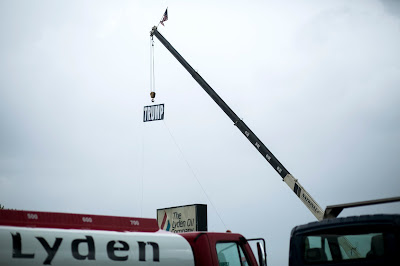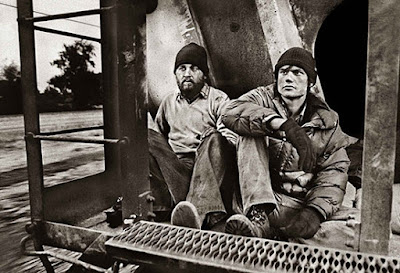I’ve just
finished reading ‘Lean On Pete’ by Willy Vlautin, American novelist and former
lead singer with Richmond Fontaine. It details the story of a lonely 15 year old,
Charley Thompson, who finds himself in Portland, Oregon after his father, his
only parent, moves them there looking for work and running from their previous
life in Spokane, for reasons never fully explained. This moving on, however, is
an unsettling frequent occurrence in Charley’s life and makes it impossible for
him to form any lasting and meaningful relationships. That is until he
befriends Pete, a racehorse at the local run-down racetrack who is owned by
Del, his grizzled and hardened trainer, who offers the boy a job feeding his
horses and cleaning out his stables. Charley is desperate for work, as his
father often leaves him on his own for days as he works late or sleeps over with
his latest girlfriend, leaving Charley very little money to feed himself, forcing him to often shoplift, before he
begins working with Del. Without giving too much away as for the reasons why,
the second part of the book sees Charley running away from Portland with Pete,
embarking on a journey that takes him thousands of miles across America to seek
his lost aunt.
In a
consistently bleak and sad story the novel then takes the shape of a
contemporary Huckleberry Finn tale, where instead of travelling with the slave,
Jim, we follow the narrator, Charley, travelling with Pete across an
unforgivingly harsh landscape from one US town to another, eating and sleeping
where he can: under bushes by the river; hidden in parking lots at the back of
stores or take-aways and restaurants, and meeting various assorted characters
along the way. Characters who are often in their own individual ways living on
the frayed and tattered edges of society trying to get by and looking for
something better than the lives they find themselves trapped in. You know it is
never going to happen though, and Vlautin’s writing, despite the spare prose
style, always possesses a deep non-judgemental compassion for the characters he
writes about and the lives they find themselves living. In an increasingly
unequal world in the West, I think we are all just a heartbeat from it in many
ways. I also guess, to simplistically put it, some of these characters
represent the desperate people ‘left behind’ by the politics of neo-liberalism
and who are seeking some sort of alternative future or stake in a society they
no longer recognise or feel they belong to, and from this we now have Trump as
US President and Brexit here in the UK.
Michael Williamson, 'Journey To Nowhere: The Saga of the New Underclass'
I was very moved by the book, and enjoyed seeing
the world through the eyes of the young teenager, Charley. I admired Vlautin’s objective
expression, with circumstances and situations never really explained but
instead presented as just the way things
are. I was reminded of my own ideas in relation to my painting and how I
have also been interested, especially in the last fifteen years or so, in
deliberately presenting my subject matter in a similarly objective, almost
flat-footed way at some sort of remove. This approach has been influenced by many
different interests in painting, photography, film and literature, which
include the work of Chuck Close, Catherine Murphy, Stephen Shore, and Roy
Fisher, amongst many others. I found
myself making a further connection between ‘Lean On Pete’ and the world documented
in ‘Journey To Nowhere: The Saga of the New Underclass’, a book I read at the
end of last year.
Published in the Eighties, it is a riveting, moving and
heartbreaking document made by journalist Dale Maharidge and photographer Michael Williamson of America from the time they were sent ‘out in the field’
by their newspaper editor to record the effects the recession hit Reagan era
was having on the lives of the people in the former industrial towns and cities
of the US. In places like Youngstown, Ohio and many others they recorded the
stories of ordinary men and women and the impact on their lives as factory upon
factory closed down, leaving whole communities and even states decimated as
workers lost their jobs, were forced to sell up and ended up taking to the road
to seek alternative work and new
opportunities.
Photos by Michael Williamson
It is unremittingly bleak at times as we follow
the lives of individuals and families living a life of homeless desperation,
sleeping in cars, and perilously jumping the railroads from city to city, yet there
is something powerfully uplifting about the people we meet in the book, and the
photographs are stunning. ‘Journey To
Nowhere’ presents the reality of the so-called ‘American Dream’ or ‘The
Promised Land’ and provides an unarguable context for the mess the US is in now
with Trump.
oil on canvas, 70 x 90cms, 2017
Which all
brings me to talk about some of the paintings I have made in recent months
which link some of these connections together. After reading ‘Lean On Pete’, I
worked for several weeks on the painting above which depicts two wheelie bins
photographed at the back of my local mini supermarket. Admittedly, the
motivation behind the photograph was my attraction to the subject was the
colour and form and my interest in objects like these found in my urban
surroundings, almost as ‘found’ still lives. When I started painting it
however, I was reminded of the book and Charley’s attempts each night, as a
homeless runaway, to find a place to safely hide and sleep each night, and
thought that this was just the sort of place you might find him in. Indeed, you
do increasingly find the homeless begging outside the store during the day.
This seemed to imbue with the image with a different sort of resonance. Like
many others, I find myself shocked and appalled at the clearly visible massive
rise in homelessness in Birmingham, and across the country, as a result of this
terrible Tory government’s policies that seem to particularly target the poor,
underprivileged and vulnerable: the Bedroom Tax; the scrapping of housing
benefit for the under-21’s; cruel benefit sanctions; work capability
assessments etc.
oil on canvas, 36 x 46cms, 2017
I felt the
painting became too overworked in the end and put it to one side. I have
attempted a smaller version too (above), but don’t feel this quite got there
either. However, my interest in the theme remains, and a few months ago on the
way to work I observed on some overgrown, fly-tipped land that runs alongside
the road between the factories and the ring road that surround the college,
that a series of makeshift shelters constructed from old sleeping bags, tarpaulin,
tents, hanging over branches and pitched amongst the rubbish, had appeared.
With a shock I realized that they were ‘housing’ some of the city’s homeless
and I was looking at, what you would call in America, Birmingham’s very own
‘hobo jungle’. I thought that the shelters were now abandoned, and ended up
cautiously stepping amongst them and taking a few photographs, feeling
compelled to record the scene in some ways, but on returning past I realised
that they are still occupied. It’s a terribly sad sight and an insight into the
reality of so many people’s lives, and a real indictment of how lost we
currently are as a society.
Charcoal on paper, 50 x 70cms, 2017
oil on canvas, 50 x 70cms, 2017
Since then I have found myself almost
tentatively developing some drawings first, and then some paintings based on my
photographs of these shelters. It has not been easy trying to approach the
paintings- these are my first paintings not set at night for a few years as
much as anything- but also trying to consider suitable ways to represent them
in paint has been an issue. My first painting I think became too overworked
looking at it now. The drawing I made first is more interesting, and I think
the painting needs to be much larger. The preceding one of this tarpaulin
shelter on the pavement was very difficult too, as it such an unusual sight and
form amongst its surroundings: I’m unsure how it will be ‘read’ at all, but I
am happier with it. I worked on and off on it for a long time.
oil on canvas, 70 x 55cms, 2017
These two smaller ones were painted over
existing canvasses and I have tried to incorporate the underlying painting and
texture as a feature in them. I’m particularly pleased with the ‘tent’ and want
to do something much larger with this one as I think it is has a lot of ‘image
power’. I am thinking about attempting
to paint a second, slightly larger version, of the other painting, too which
depicts a pair of trousers hanging over some branches in a copse in case you
were wondering.
oil on canvas, 25 x 40cms, 2017
oil on canvas, 25 x 40cms
It is this most recent one, however, that I’m
most pleased with, which I ended up painting directly in one session. I like
the directness of the handling, which is how I prefer to work still: it is
simpler and better for that in terms of its relationship to the theme: these
scenes of the local environment ‘disrupted’ by the shelters. This is how I
intend to attempt to paint the next few I am working on. They almost seem like
images of the ruins of a society at the edge of collapse, which seems
appropriate given the current situation.
oil on canvas, 40 x 60cms, 2017
It’s
interesting joining these threads together in this long post. You can see that
although sometimes the work that is eventually made is created in a relatively
short period, it often grows out of a long period of gestation of different
ideas, thoughts, influences and experiences. These recent paintings seem to be taking my so-called 'edgelands' work down a different, more overt social and political path that I'm unsure about but I find it hard to turn my head away from these issues. It seems inevitable that they are beginning to feature more and more in my work.
















